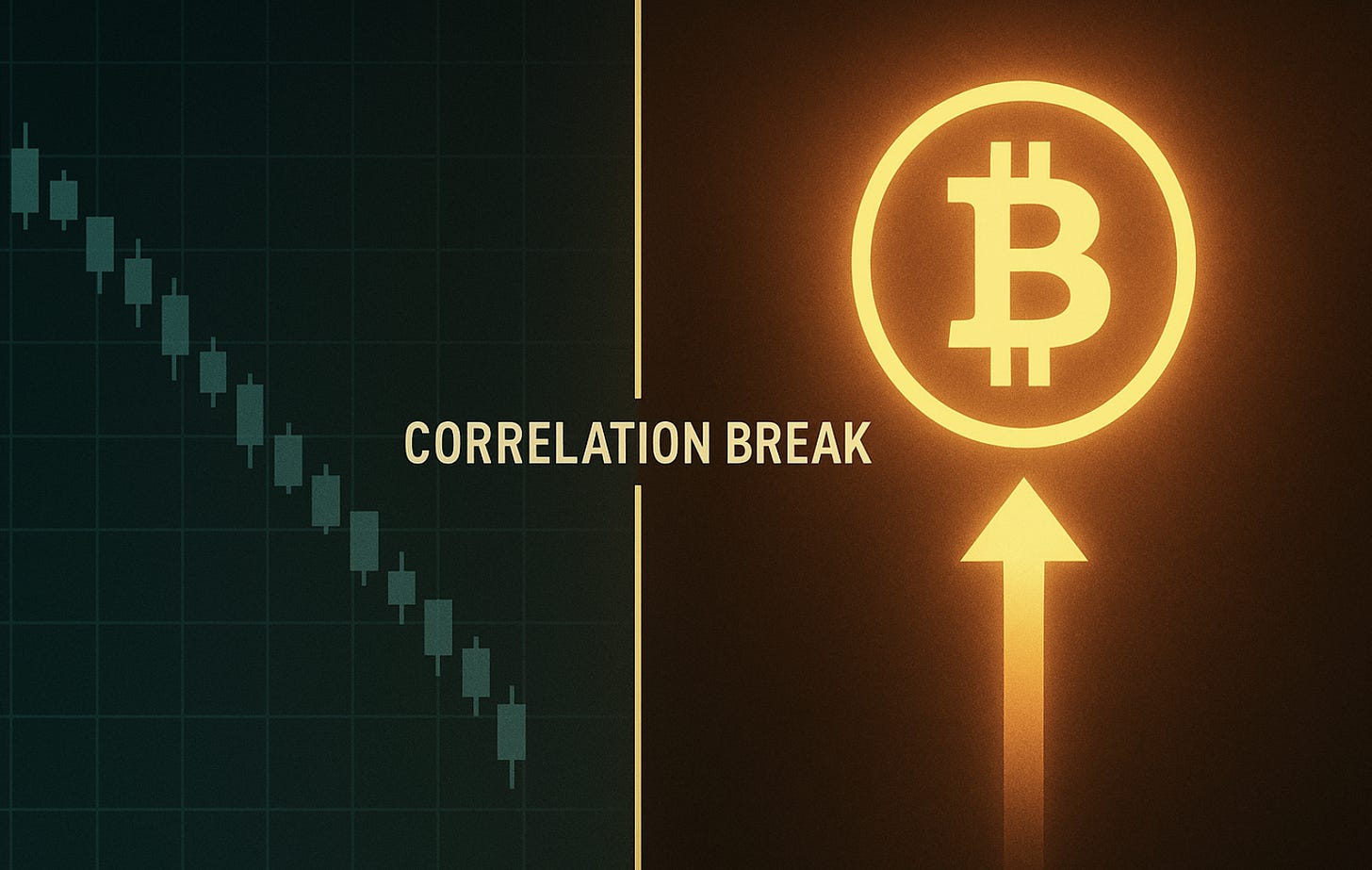Bitcoin’s Breakaway Moment: Why Its Falling Correlation to Risk Assets Matters More Than Investors Realize
Bitcoin has spent years being dismissed as a volatile proxy for tech stocks, but something quieter and far more consequential has been unfolding beneath the surface: its correlation to traditional risk assets has slipped to multi-year lows¹. The shift went largely unnoticed, even though it may be the clearest sign yet that Bitcoin is maturing into an asset with its own drivers rather than merely shadowing the Nasdaq.
For much of the last decade, Bitcoin and high-growth equities moved almost in unison. During the liquidity boom of 2021, the two traded “joined at the hip,” and through the brutal selloff of 2022, Bitcoin fell in step with tech as interest rates surged². At times, the 30-day correlation was near 1:1, framing Bitcoin as little more than a high-beta version of the Nasdaq³. The label stuck.
Recent data, however, shows the relationship breaking down. In 2024, Bitcoin and the Nasdaq moved together on barely half of all trading days⁴. The rolling 30-day correlation fell to 0.46, its weakest in years⁵. Bitcoin’s correlation with the S&P 500 sat even lower, near 19%⁶. The pattern suggests Bitcoin is beginning to respond to its own set of catalysts rather than tracking earnings-driven equity risk sentiment.
A striking example came in March 2023, when regional banks in the U.S. were wobbling and equities turned defensive. Bitcoin surged more than 20% while the S&P 500 faded⁷. Gold rose modestly, but Bitcoin outperformed both traditional safe havens and risk assets. Short-term correlations even turned slightly negative⁸. Reuters captured the moment with a simple headline: *“Bitcoin passes the bank stress test.”*⁹
Episodes like that were once rare. They are now occurring more often.
Decoupling When Stress Hits
Another clear break appeared in November 2024. In the week following the U.S. presidential election, Bitcoin pushed to a fresh all-time high near $93,000 while the Nasdaq 100 softened¹⁰. Historically, Bitcoin rarely rallied when equities cooled, yet that is precisely what happened. By mid-November, it ranked among the world’s largest assets, and analysts described its behavior as “independent market performance.”¹¹
This divergence extended into 2025. Trade tensions between the U.S. and China weighed on stocks, yet Bitcoin held firm near its highs¹². In April, a leveraged Nasdaq index tumbled on geopolitical concerns while Bitcoin remained resilient, a moment one analyst said showed Bitcoin “acting as a macro hedge during uncertainty.”¹³
There were also periods when Bitcoin rallied on crypto-specific catalysts while equities barely responded. In July 2025, optimism around regulatory clarity and ETF developments pushed Bitcoin sharply higher even as tech stocks traded sideways¹⁴. Research from 21Shares argued that Bitcoin’s ability to decouple in multiple directions—sometimes amplifying returns, sometimes buffering volatility—is becoming a core feature of its market structure¹⁵.
A Broader Investor Base, A Broader Narrative
Why is the correlation breaking down? The simplest answer is that Bitcoin is no longer owned or traded like a niche speculative asset.
Its holder base now spans hedge funds, retail investors, family offices, corporations, and even governments. Each group values Bitcoin differently. Some view it as digital gold. Others treat it as a macro hedge, a liquidity proxy, a call option on future monetary regimes, or a growth asset tied to network adoption. With so many competing narratives, Bitcoin often responds to a wider set of forces than equities do.
This diversification of motives has helped Bitcoin develop a more complex price identity. As one industry report put it, Bitcoin “behaves like a growth asset in some macro regimes and like a hedge in others,” and that duality is now showing up in correlation data¹⁶.
Volatility has also moderated, another sign of maturation. Implied volatility, once well above 100%, has drifted lower as Bitcoin’s market size and institutional adoption have expanded¹⁷. Bitcoin still swings, but its movement is no longer exclusively tied to equity sentiment or speculative excess.
A Coindesk report noted this shift with blunt clarity: because Bitcoin is now one of the world’s largest assets, “the market has a better understanding of it, and it trades more on its own terms.”¹⁸
Not a Perfect Hedge—Yet Something New
None of this suggests Bitcoin has fully morphed into a safe haven. Correlations rise and fall, especially in liquidity crunches when “all correlations go to one.” Even in 2025, correlations swung dramatically: the S&P 500 correlation fell to 0.45 in early April but rebounded above 0.80 later that spring¹⁹. Bitcoin is still part of a global risk ecosystem, and panic can pull everything down at once.
Keep reading with a 7-day free trial
Subscribe to The Lead-Lag Report to keep reading this post and get 7 days of free access to the full post archives.



